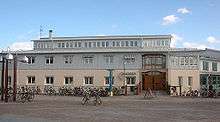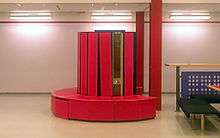Linköping University
| Linköpings universitet | |
|
Seal of Linköping University[1] | |
| Type | Public university |
|---|---|
| Established | 1969/1975 |
| President | Dr. Helen Dannetun |
Administrative staff | 3,703 (FTE, 2015) |
| Students | 17,432 (FTE, 2015)[2] |
| 1,308 (2015) | |
| Location |
|
| Campus | 4: Campus Valla, Campus US, Campus Norrköping, Campus Lidingö |
| Colors |
Blue, Turquoise and Green [3] |
| Affiliations | EUA, ECIU |
| Website | www.liu.se |
 | |
Linköping University (in Swedish: Linköpings universitet, LiU) is a state university in Linköping, Sweden. Linköping University was granted full university status in 1975 and is now one of Sweden's larger academic institutions.[4] Education, research and PhD training are the mission of four faculties: Arts and Sciences, Educational Sciences, Medicine and Health Sciences and the Institute of Technology.[5] In order to facilitate interdisciplinary work, there are 14 large departments combining knowledge from several disciplines and often belonging under more than one faculty.[6] Linköping University emphasises dialogue with the surrounding business sphere and the community at large, both in terms of research and education.[7] In 2015, Linköping University was home to 27,000 students and 4,000 employees.[8]
History









The origins of Linköping University date back to the 1960s. In 1965, The Swedish National Legislative Assembly (Riksdag) decided to locate some programmes within the fields of technology and medicine to Linköping. In 1967 a branch of Stockholm University was placed in Linköping, offering education within humanities, social sciences and natural sciences. Two years later a unit for medical training and the Institute of Technology were established. In 1970 all activities were brought together in three faculties within the Linköping University College: the Faculty of Arts and Sciences, the Faculty of Medicine and the Institute of Technology. Linköping University was established in 1975.
In 1977 former teacher training colleges in Linköping and Norrköping were transferred to Linköping University and in 1986 the Faculty of Health Sciences was formed, based on the faculty of medicine and regional funded education in health care professions. In 1997 a campus was opened in the neighbouring city of Norrköping. The renowned Carl Malmsten School of Furniture has been part of Linköping University since 2000. After almost 60 years at the city centre, the school moved into new premises on the outskirts of Stockholm in 2009.[9]
Research
Linköping University pursues research and postgraduate studies within the fields of technology, medicine, and humanities, natural, educational, social and behavioural sciences. It is particularly noted for its openness to multidisciplinary research and, in 1980, was the first Swedish university to introduce interdisciplinary thematic research at the Faculty of Arts and Sciences, and a cross-subject, interdisciplinary perspective in graduate schools for PhD students.[10]
Linköping University receives research grants from the Swedish government within five strategic research areas: IT and mobile communication, materials science, security and emergency management, e-Science and transport research.[11]
Education
Linköping University offers education at the basic and advanced levels via 120 study programmes, 550 single-subject courses and specialised as well as interdisciplinary postgraduate studies. A large number of the degree programmes lead to qualified professional degrees in fields such as medicine, business and economics, teacher education and engineering. Many of the programmes are interdisciplinary, combining for example industrial management and engineering, medicine and engineering, or integrating economics, law and languages.[12] In 1986 the Faculty of Health Sciences became the first faculty in Sweden to put problem-based learning into practice within medical training and health-care programmes. In 2007, the Medical Programme and the Department of Electrical Engineering, Control systems were recognised as Centres of Excellence in Higher Education by the Swedish National Agency for Higher Education. The recognition was based on a thorough quality assessment by a panel of experts.[13]
Faculties
- Faculty of Arts and Sciences (Filosofiska fakulteten)
- Faculty of Medicine and Health Sciences (Medicinska fakulteten/Hälsouniversitetet) and Linköping University Hospital
- Linköping Institute of Technology (Linköpings tekniska högskola)
- Faculty of Educational Sciences (Utbildningsvetenskap)
University campuses
Education and research are conducted at three campuses in the cities of Linköping and Norrköping, situated approximately 200-160 kilometres south of Stockholm, and a fourth campus in Lidingö, Stockholm.[14]
- Campus Valla, about three kilometers from the city centre of Linköping, is where the majority of students and researchers study and work.
- The University Hospital campus in Linköping houses the Faculty of Medicine and Health Sciences.
- Campus Norrköping, is a city campus 40 kilometres northeast of Linköping. About one-fourth of the students are enrolled here.
- The Carl Malmsten School of Furniture has been part of Linköping University since 2000. After almost 60 years at the city centre, the school moved into new premises in Lidingö, on the outskirts of Stockholm in 2009.
Research centres, selection of
- Control, Autonomy, and Decision-making in Complex Systems (Linnaeus Centre CADICS)
- Disaster Medicine (KcKM/Z), Centre of
- Gender Excellence (GEXcel), The Swedish Research Council Centre of
- Hearing and Deafness (Linnaeus Centre HEAD), Research on
- The National Supercomputer Centre, a provider of national supercomputing resources
- Novel Functional Materials (Linnécentrum LiLI-NFM), Linköping Linnaeus Initiative for
- Organic Bioelektronics (OBOE), Strategic Research Centre for
- Norrköping Visualization Center C, in cooperation with the City of Norrköping and Norrköping Science Park and Interactive Institute. The Dome Theater, constructed in 2009, is the most technically advanced dome in northern Europe.[15]
For a complete list of centres, see Departments and Centres at Linköping University
Science parks
Two science parks are closely connected to Linköping University.
- Mjärdevi Science Park in Linköping hosts 250 technology companies, from start-ups to multinationals, with 6,100 employees. The largest residents of Mjärdevi are Ericsson, IFS and Infor. Major multinationals such as ARRIS Group, Flextronics, Autoliv and Toyota Industries are also represented.[16]
- Norrköping Science Park in Norrköping hosts approximately 100 companies. Main areas for research and development are printed electronics, interactivity and visualisation.[17]
Popular culture
Mentioned in the Hollywood movie Agent Cody Banks. "...The most impressive tests on microsurgery were conducted at Sweden's Linköping University..." [18]
Notable faculty
- Gerhard Andersson, Professor of Clinical Psychology
- Anders Blomqvist, Professor of Pain Research
- Christian Berggren, Professor of Industrial Management
- Magnus Berggren, Professor of Organic Electronics
- Per-Erik Ellström, Professor of Education
- Fredrik Gustafsson, Professor of Sensor Informatics
- Lars Hultman, Professor of Materials Science
- Olle Inganäs, Professor of Organic Electronics
- Lennart Ljung, Professor of Control Theory
- Nina Lykke, Professor of Gender Studies
- Jan-Ove Palmberg, Professor of Mechanical Engineering
- Jerker Rönnberg, Professor of Psychology
- Carl-Ulrik Schierup, Professor of Ethnicity
- Tatyana Shaposhnikova, Professor of Mathematics
- Stefan Thor, Professor of Biology
- Anthony Turner, Professor of Biosensors and Bioelectronics
Notable former faculty
- Stig Hagström, Professor Emeritus of Materials Science
- One of the founders of Linköping University
- Leading researcher in materials science
- Harold Lawson, former Professor of Telecommunications and Computer Systems
- Credited with the invention of the pointer in programming languages
- ACM Fellow
- Ingemar Lundström, Professor Emeritus of Applied Physics
- Leading researcher in biosensors and chemical sensors
- Chairman for the Nobel Committee for Physics
- Hans Rådström, former Professor of Applied Mathematics
- Mathematician who made many important contributions
- Erik Sandewall, Professor Emeritus of Computer Science
- Leading researcher in artificial intelligence
- AAAI Fellow
- Vladimir Gilelevich Maz'ya, Professor Emeritus of Mathematics
- Known for his work on Sobolev spaces
- Åke Öberg, Professor Emeritus of Biomedical Engineering
- Leading researcher in circulatory physiology, bio-optics, biomedical instrumentation, sensors and clinical engineering
Notable alumni
- Pär Boman, President and CEO, Svenska Handelsbanken
- Jan Carlson, CEO, Autoliv
- Carl-Henric Svanberg, Chairman of BP and Volvo, former CEO of Ericsson
- Bo Dankis, President, Business Sweden (former Swedish Trade Council)
- Per Håkan Börjesson, - CEO of Investment AB Spiltan and Author.
- Conni Jonsson, Founder and Chairman of EQT Partners AB.
- Nashwa Eassa
- Göran Espelund, Chairman of Lannebo Fonder
- Håkan Eriksson, former Senior Vice President for Research, Ericsson
- Anders Flodström, professor of Materials physics at the Royal Institute of Technology, former Rector of the Royal Institute of Technology, former University Chancellor of Sweden and Head of the Swedish National Agency for Higher Education
- Gustav Fridolin, Minister for Education in the Government of Sweden
- Jan Malm, former CEO, Ericsson China, 2000–2004
- Bengt Nilsson, Co-founder and former CEO (now Vice Chair of the Board) of Industrial and Financial Systems (IFS)
- Jan-Eric Sundgren, former Rector of Chalmers Institute of Technology, now Senior Vice President, Volvo Group
- Ola Tunander, Research Professor at the Peace Research Institute Oslo
- Åke Svensson, Director General of Teknikföretagen (employers' organisation for engineering companies), former President and CEO Saab AB
- Björn von Sydow, former Speaker of the Riksdag and Minister for Defence 1997-2002
- Cecilia Widegren, Member of the Riksdag and Vice Chairman in The Parliamentary Defense Committee and Group
- Zhong Zhihua, Rector of Hunan University, Member of the Chinese Academy of Engineering
| Wikimedia Commons has media related to Linköping University. |
See also
- List of universities in Sweden
- Lysator. The oldest computer society in Sweden. Founded in 1973.
Notes
- ↑ "New look for LiU". Linköping University. 2015-05-20. Retrieved 2015-08-13.
- ↑ "Facts & figures". Linköping University. Retrieved 2016-02-22.
- ↑ "Grafisk manual" (PDF). Linköping University. Retrieved 14 August 2015.
- ↑ "History of Linköping University". Linköping University. Retrieved 2014-09-08.
- ↑ "Faculties". Linköping University. Retrieved 2014-09-08.
- ↑ "Departments". Linköping University. Retrieved 2014-09-08.
- ↑ "Introduction collaboration". Linköping University. Retrieved 2014-09-08.
- ↑ "Facts & figures". Linköping University. Retrieved 2016-02-22.
- ↑ "History of Linköping University". Linköping University. Retrieved 2014-09-08.
- ↑ "Introduction research". Linköping University. Retrieved 2014-09-08.
- ↑ "Strategic research areas". Linköping University. Retrieved 2014-09-08.
- ↑ "Introduction Education". Linköping University. Retrieved 2011-11-23.
- ↑ "Centres of Excellence in Higher Education". Swedish National Agency for Higher Education. Retrieved 2011-11-23.
- ↑ "Campuses". Linköping University. Retrieved 2011-12-09.
- ↑ "About C". Norrköping Visualization Center C. Retrieved 2011-11-23.
- ↑ "Mjärdevi Science Park". Mjärdevi Science Park. Retrieved 2011-11-23.
- ↑ "Norrköping Science Park". Norrköping Science Park. Retrieved 2011-11-23.
- ↑ Script of Agent Cody Bank
External links
- Linköping University - Official site in English
- Campuses at LiU
- Visualization Center C
Coordinates: 58°23′57″N 15°34′37″E / 58.39917°N 15.57694°E
